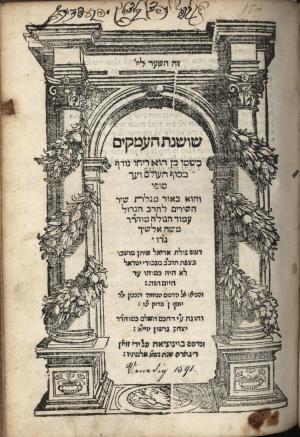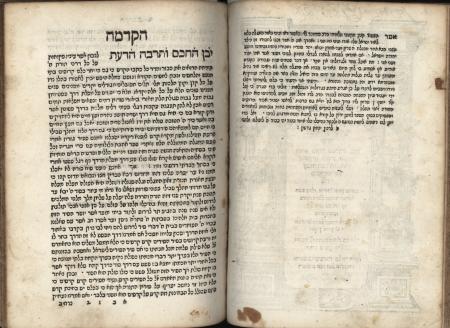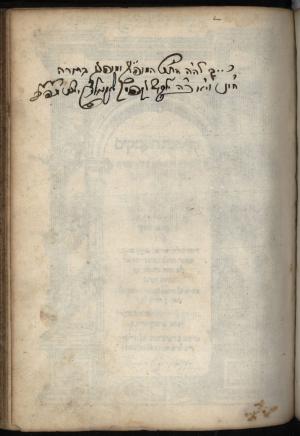Obj. ID: 39585
Jewish printed books Shoshanat ha-'Amukim by Moshe ben Chaim Alshekh, 1508 - c.1600, Venice, 1591

This text was prepared by William Gross:
"Shoshanat ha-'Amuqim" (Lily of the Valleys), on the Song of Songs. This commentary was the first to appear in print, and was edited by the author himself in 1591. According to this commentary, the Song of Songs is an allegory, and represents a dialogue between God and exiled Israel on the latter's mission.
R. Moshe b. Hayyim Alshekh (c.1508 - c.1600), was born in Adrianople. He lived most of his life in Safed and died in Damascus. He was a student, in his birthplace, of R. Joseph Caro, and afterwards in Salonika of R. Joseph Taitazak. After settling in Safed, R. Alshekh established two yeshivot, counting among his students R. Hayyim Vital. He received ordination from R. Joseph Caro, during the brief period that ordination was rinstituted, adn served as dayyan on R. Caro's rabbinic court. Although primarily a talmudist and halakhist, R. Alshekh preached on Shabbat, delivered sermons based on his biblical exegesis, from which his biblical commentaries are derived. .In the preface to his commentary on the Pentateuch he says: “ I never aimed at things too high or beyond me. From my earliest days the study of the Talmud was my chief occupation, and I assiduously attended the yeshivah where I made myself familiar with the discussions of Abaye and Raba. The night I devoted to research and the day to Halakha. In the morning I read the Talmud and in the afternoon the Posekim (Rabbinic legal decisions). Only on Fridays could I find time for the reading of Scripture and Midrash in preparation for my lectures on the Sidra of the week and similar topics, which I delivered every Sabbath before large audiences, eager to listen to my instruction.” These lectures were afterward published as "Commentaries" (perushim) on the books of the Holy Scriptures, and R. Alshekh gives a remarkable reason for their publication: "Many of those who had listened to my lectures repeated them partly or wholly in their own names. These offenses will be prevented by the publication of my own work". These lectures, though somewhat lengthy, were not tedious to his audience. The author repeatedly declares that in their printed form (as "Commentaries") he greatly curtailed them by omitting everything which was not absolutely necessary, or which he had already mentioned in another place.
Kabbalistic commentary to the five scrolls by R. Moses b. Hayyim Alshekh (c. 1520-1593), rabbi and Bible commentator, born in Adrianople or Damascus. He studied in Salonika under R. Joseph Taitazak and R. Joseph Caro, and then emigrated to Erez Israel, settling in Safed, where he gained prominence as an halakhic authority, a teacher in two talmudic academies, and a preacher. He was active in communal affairs and was a member of the rabbinical court of R. Joseph Caro, who conferred upon him the full ordination which had been reintroduced by R. Jacob Berab. The Alshekh in turn ordained in 1590 R. Hayyim Vital, who was his disciple in halakhah. His major field of interest was halakhah but, acceding to requests to preach on Sabbaths, in the course of preparing his sermons he occupied himself also with Bible exegesis. He also engaged in the study of the Kabbalah, from which he derived the fundamentals of his religious philosophy. According to one tradition, R. Isaac Luria sought to dissuade him from pursuing kabbalistic studies. About 1590 The Alshekh visited the Jewish communities of Syria and Turkey, and perhaps also of Persia, in the interests of Safed Jewry. He also sent an appeal on behalf of the Safed community to Italy and other countries. The last information about him was from Damascus. He participated there in a rabbinical court session in the spring of 1593. He died soon after at a venerable age.
The printer Giovanni di Gara (active 1564-1610) was known in Venice as the “heir of Bomberg” not only because Bomberg instructed him in Hebrew printing, but also because Di Gara acquired most of Bomberg’s Hebrew types. He was born in Riva del Garda to Christian parents sometime between 1520 and 1530 and moved to Venice with his family as a young boy. He began working at Bomberg’s press as a child. It is believed Di Gara’s first Hebrew books were printed at Bomberg’s own press, since some of them bear the phrase “in the house of Bomberg”. In other early Hebrew books, Di Gara noted when he used Bomberg’s types with the phrase “with the letters of Bomberg”. Over time, this phrase came to mean ‘in the Bomberg style’.
Di Gara worked closely with the press of fellow Venetian Bragadini, as evidenced by the use of his types from 1599 to 1600 and the incorporation of his three-crown printer’s mark (Di Gara’s own printer’s mark was a small single crown). Di Gara employed Jews whenever legally permitted to do so to ensure the accuracy of his Hebrew editions. Books printed under the supervision of Christian typesetters suffered from many errors, whose corrections were costly to the firm.
Di Gara’s press printed close to 300 Hebrew books from approximately 1565 until his death in 1609 (at least one Hebrew book was printed posthumously from his press in 1610).
Architectural title page with vine-wrapped columns. Bound with three other books from the same period in the original binding: B.921, B.2244, B.2245




